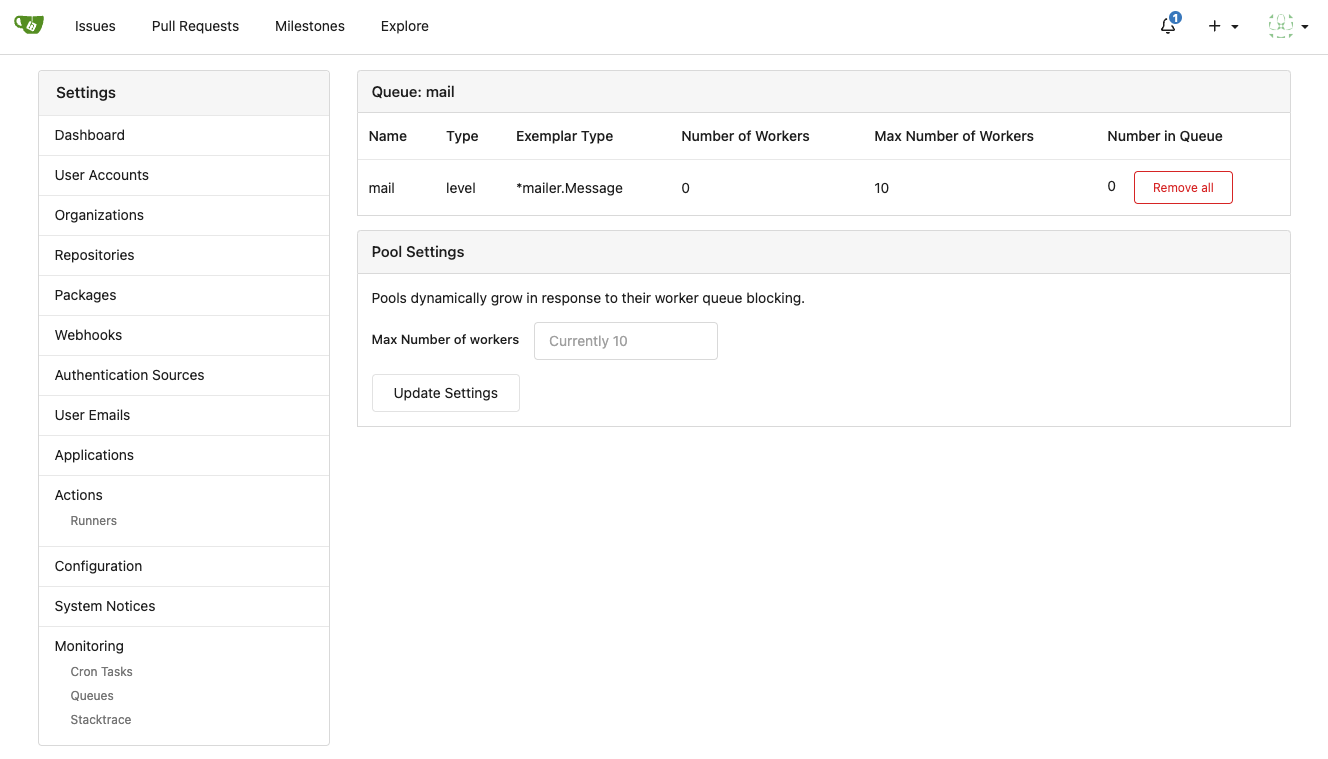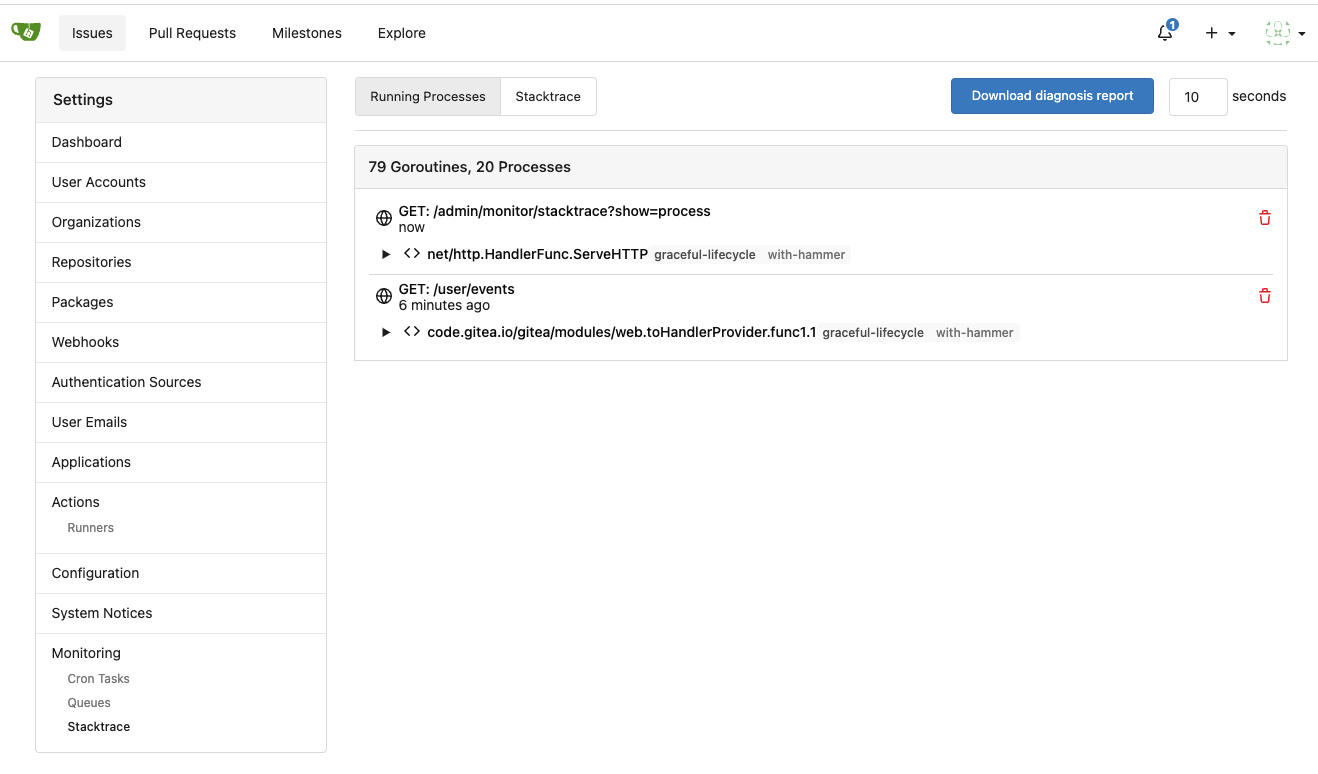mirror of
https://gitcode.com/gitea/gitea.git
synced 2025-10-25 12:26:40 +08:00
Although some features are mixed together in this PR, this PR is not
that large, and these features are all related.
Actually there are more than 70 lines are for a toy "test queue", so
this PR is quite simple.
Major features:
1. Allow site admin to clear a queue (remove all items in a queue)
* Because there is no transaction, the "unique queue" could be corrupted
in rare cases, that's unfixable.
* eg: the item is in the "set" but not in the "list", so the item would
never be able to be pushed into the queue.
* Now site admin could simply clear the queue, then everything becomes
correct, the lost items could be re-pushed into queue by future
operations.
3. Split the "admin/monitor" to separate pages
4. Allow to download diagnosis report
* In history, there were many users reporting that Gitea queue gets
stuck, or Gitea's CPU is 100%
* With diagnosis report, maintainers could know what happens clearly
The diagnosis report sample:
[gitea-diagnosis-20230510-192913.zip](https://github.com/go-gitea/gitea/files/11441346/gitea-diagnosis-20230510-192913.zip)
, use "go tool pprof profile.dat" to view the report.
Screenshots:



---------
Co-authored-by: Jason Song <i@wolfogre.com>
Co-authored-by: Giteabot <teabot@gitea.io>
97 lines
2.3 KiB
Go
97 lines
2.3 KiB
Go
// Copyright 2023 The Gitea Authors. All rights reserved.
|
|
// SPDX-License-Identifier: MIT
|
|
|
|
package queue
|
|
|
|
import (
|
|
"context"
|
|
"sync"
|
|
"unsafe"
|
|
|
|
"code.gitea.io/gitea/modules/nosql"
|
|
|
|
"gitea.com/lunny/levelqueue"
|
|
"github.com/syndtr/goleveldb/leveldb"
|
|
)
|
|
|
|
type baseLevelQueueUnique struct {
|
|
internal *levelqueue.UniqueQueue
|
|
conn string
|
|
cfg *BaseConfig
|
|
|
|
mu sync.Mutex // the levelqueue.UniqueQueue is not thread-safe, there is no mutex protecting the underlying queue&set together
|
|
}
|
|
|
|
var _ baseQueue = (*baseLevelQueueUnique)(nil)
|
|
|
|
func newBaseLevelQueueUnique(cfg *BaseConfig) (baseQueue, error) {
|
|
conn, db, err := prepareLevelDB(cfg)
|
|
if err != nil {
|
|
return nil, err
|
|
}
|
|
q := &baseLevelQueueUnique{conn: conn, cfg: cfg}
|
|
q.internal, err = levelqueue.NewUniqueQueue(db, []byte(cfg.QueueFullName), []byte(cfg.SetFullName), false)
|
|
if err != nil {
|
|
return nil, err
|
|
}
|
|
|
|
return q, nil
|
|
}
|
|
|
|
func (q *baseLevelQueueUnique) PushItem(ctx context.Context, data []byte) error {
|
|
return baseLevelQueueCommon(q.cfg, q.internal, &q.mu).PushItem(ctx, data)
|
|
}
|
|
|
|
func (q *baseLevelQueueUnique) PopItem(ctx context.Context) ([]byte, error) {
|
|
return baseLevelQueueCommon(q.cfg, q.internal, &q.mu).PopItem(ctx)
|
|
}
|
|
|
|
func (q *baseLevelQueueUnique) HasItem(ctx context.Context, data []byte) (bool, error) {
|
|
q.mu.Lock()
|
|
defer q.mu.Unlock()
|
|
return q.internal.Has(data)
|
|
}
|
|
|
|
func (q *baseLevelQueueUnique) Len(ctx context.Context) (int, error) {
|
|
q.mu.Lock()
|
|
defer q.mu.Unlock()
|
|
return int(q.internal.Len()), nil
|
|
}
|
|
|
|
func (q *baseLevelQueueUnique) Close() error {
|
|
q.mu.Lock()
|
|
defer q.mu.Unlock()
|
|
err := q.internal.Close()
|
|
_ = nosql.GetManager().CloseLevelDB(q.conn)
|
|
return err
|
|
}
|
|
|
|
func (q *baseLevelQueueUnique) RemoveAll(ctx context.Context) error {
|
|
q.mu.Lock()
|
|
defer q.mu.Unlock()
|
|
|
|
type levelUniqueQueue struct {
|
|
q *levelqueue.Queue
|
|
set *levelqueue.Set
|
|
db *leveldb.DB
|
|
}
|
|
lq := (*levelUniqueQueue)(unsafe.Pointer(q.internal))
|
|
|
|
for lq.q.Len() > 0 {
|
|
if _, err := lq.q.LPop(); err != nil {
|
|
return err
|
|
}
|
|
}
|
|
|
|
// the "set" must be cleared after the "list" because there is no transaction.
|
|
// it's better to have duplicate items than losing items.
|
|
members, err := lq.set.Members()
|
|
if err != nil {
|
|
return err // seriously corrupted
|
|
}
|
|
for _, v := range members {
|
|
_, _ = lq.set.Remove(v)
|
|
}
|
|
return nil
|
|
}
|